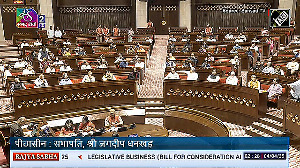The 'cement story' is once again in the limelight. The fact that demand is likely to outpace supply and therefore, cement prices are likely to firm up is being heard on the streets time and again. We therefore, take a closer look at the fundamentals.
First a brief look at the sector fundamentals. While the industry capacity in FY04 stood at 146 MT (million tonnes), consumption i.e. demand was at 122 MT (production at 124 MT). Over the last 11 years, while capacity has grown at a CAGR of 7.5%, consumption has outpaced capacity at 8.7%.
The graph below indicates how the demand-supply situation has moved over an 11-year period. As is evident, with demand growing at a faster rate than supply, the industry is definitely moving towards a favorable pricing scenario.

 While the overall industry trend sounds positives, cement sector in India has to be studied on a regional basis (due to high freight costs for transporting cement). The graph below highlights the demand-supply situation in key regions.
While the overall industry trend sounds positives, cement sector in India has to be studied on a regional basis (due to high freight costs for transporting cement). The graph below highlights the demand-supply situation in key regions.
As is evident, most of the northern and western markets have high capacity utilization levels. This indicates that the pricing situation is likely to be more favorable in these markets. Key players in these regions like ACC, L&T, Grasim and Gujarat Ambuja.
With no major capacity expansions on the anvil (the next major expansion is likely to increase supply only in FY06), cement prices are likely to be higher than the past three years for the aforesaid players.
While the supply side has been dealt with in detail till now, consider the demand side of the equation. The graph below highlights the fastest growing states in the country, in terms of consumption since FY94.
While states on the eastern side like Orissa and southern regions like Karnataka have outpaced industry growth, Maharashtra is not far behind the industry average.
While we believe that the four players mentioned above are set to benefit from a favorable pricing scenario in the next two years, southern focused manufacturers like Madras Cements and India Cements will continue to lag in terms of margins.
This is because we expect the southern market to reach parity (i.e. demand equal to supply) beyond FY06. Having said that, for all cement players, the following factors are likely to keep margin expansion under control.
- Cost of transportation (freight cost) has increased, owing to the rise in petroleum product prices. These typically account for 9% to 15% of sales, depending upon manufacturers.
- Power and fuel costs are expected to increase in FY05 due to higher crude prices in the global market.
| FY04 | Grasim | Guj. Ambuja | ACC | Ultra-Tech |
| Valuation ratios | ||||
| Current price (Rs) | 1,179.0 | 362.3 | 275.9 | 314.5 |
| Price to earnings (x) | 14.4 | 19.0 | 23.6 | 101.5 |
| Price to book value (x) | 3.0 | 2.8 | 3.6 | 3.7 |
| EV/tonne (US$) | NA | 130.0 | 64.9 | 67.7 |
| Operating ratios | ||||
| EBDITA margin | 19%* | 28.2% | 11.7% | 14.1% |
| Net profit margin | 10.04%** | 17.1% | 6.1% | 1.7% |
| Return on net worth | 22.8% | 14.9% | 15.2% | 3.7% |
The table above highlights the comparative valuation and operating parameters of key players in the sector. Due to concentrated focus and synergies from acquisitions, Gujarat Ambuja and Grasim are likely to lead the pack in the future.
However, since Grasim is a diversified player with presence in sponge iron, if steel cycle were to reverse, the overall EBIT margins are likely to suffer. To that extent, one has to exercise caution.
Equitymaster.com is one of India's premier finance portals. The web site offers a user-friendly portfolio tracker, a weekly buy/sell recommendation service and research reports on India's top companies.






 © 2025
© 2025